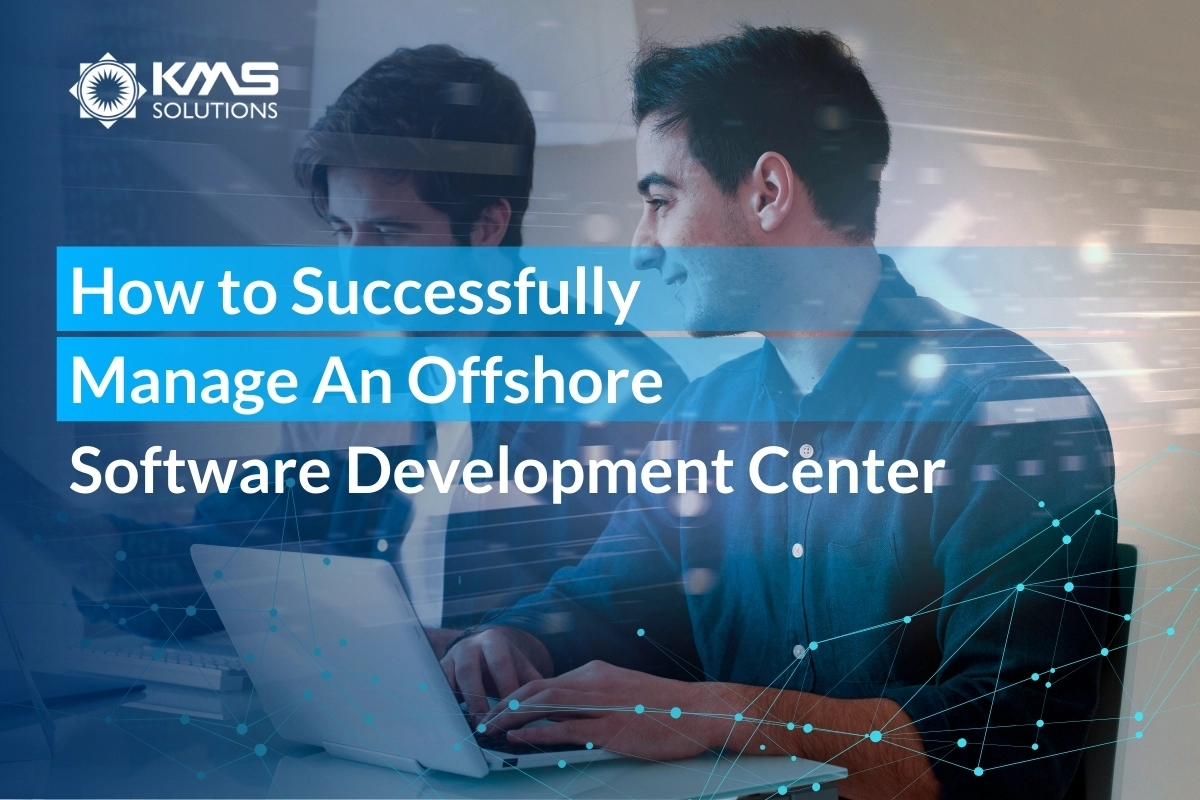In today’s tech-driven world, offshore development centers are vital to staying competitive. This practice leverages talent from around the globe, minimizing costs and accelerating project timelines.
However, managing offshore software engineers presents unique challenges, including cultural differences, communication barriers, and time zone disparities. This article explores key strategies and insights on effectively managing an offshore software development center. Let’s discover how to overcome all the challenges and barriers in the development process!
1. What is an Offshore Development Center?

An Offshore Development Center (ODC) is a team of software developers, designers, and IT professionals operating remotely from another country or region. It is a dedicated team based overseas, focused solely on delivering your company’s projects. These centers are typically set up to leverage the benefits of lower operational costs, access to a diverse talent pool, and the flexibility to scale resources based on project needs.
In the evolving landscape of global business, ODCs have become a pivotal strategy for many companies. The global outsourcing market is expected to increase to $450 billion by 2027 (Statista report), driven by the increasing demand for IT and software development services. This trend reflects a significant shift in how companies approach their development processes.
The structure and management of an ODC can vary depending on the company’s specific needs and goals. Some companies set up their own dedicated centers, while others partner with third-party providers who specialize in setting up and managing these centers.
2. How Offshore Development Center differs from Traditional Outsourcing
Offshore Software Development Center (OSDC) and Traditional Outsourcing are two common approaches companies use to extend their software development capabilities. While both methods aim to leverage external talent and resources, they have distinct differences that are shown in the table below:
| Offshore Development Center | Traditional Outsourcing | |
| Team Structure | Dedicated team with specific roles, often aligned with client’s needs. | Temporary or ad-hoc teams assigned to specific projects. |
| Engagement Type | Long-term, strategic partnership with ongoing involvement and integration. | Short-term, project-based engagements with limited ongoing interaction. |
| Control | High, client integrates team with own processes | Low, the vendor manages the team and processes |
| Quality Assurance | Direct oversight of quality and adherence to client standards. | Quality control is managed by the outsourcing vendor. |
| Initial Setup Costs | Higher due to infrastructure, hiring, and training processes | Lower, as services are often ready to use and require less setup time |
| Scalability | Easier to scale with dedicated resources | Can be challenging due to shared resources |
| Location | Typically located in a different country than the client | Can be located within the same country or overseas, but vendor choice varies |
| Security | Enhanced security protocols; direct control over security measures and processes | Security is managed by the vendor, potentially leading to varying levels of control |
While both OSDC and traditional outsourcing provide access to external expertise and cost savings, OSDC offers greater control, scalability, client involvement, and long-term collaboration, making it suitable for long-term, ongoing development projects.
Traditional outsourcing, on the other hand, is ideal for short-term projects where lower initial costs and vendor-provided infrastructure are more critical.
3. Who Should Hire Offshore Development Center Services?

Understanding who stands to gain the most from these services can help you make an informed decision about integrating them into your business strategy. Here’s a brief overview of who should consider hiring offshore development services:.
- Large Enterprises: Large enterprises that require additional development capacity for complex projects or initiatives can leverage ODCs to augment their existing teams. This approach helps in managing peak workloads and accelerating project timelines by leveraging their resources and special technical skills.
- Companies with Long-term Needs: Businesses develop products with lengthy lifecycles can use ODCs to manage various stages of the product lifecycle, from initial development to upgrades and support. These services provide dedicated teams that can align with the company’s long-term goals, ensuring continuity and stability in project execution.
- Organizations Seeking Specialized Skills: Certain projects may require niche skills or expertise that are not readily available locally. By hiring an offshore development center, organizations can tap into a global talent pool with specific technical skills and experience.
- Companies Need to Control Over Development Processes: Organizations that require tailored development processes to meet specific business needs can benefit from ODCs. This approach offers flexibility in adapting methodologies and workflows to align with company objectives and preferences.
- Businesses Looking to Reduce Operational Costs: Cost reduction is a significant driver for many companies considering offshore development center services. Offshore centers typically provide high-quality services at a reduced cost compared to onshore development teams.
4. Benefits of Offshore Development Center Services
Establishing an offshore software development center offers numerous advantages that can significantly benefit companies, especially in today’s highly competitive and technology-driven market:
4.1 Cost Efficiency

According to a report by Deloitte, companies can save up to 70% on labor and operational costs by outsourcing to some regions like India, Vietnam, the Philippines, etc. For instance, the average annual salary for a software developer in the United States is around $110,000. In contrast, in Vietnam, the cost to hire software engineers is respectively lower, which is around $18,000 to $20,000 per year for IT professionals with 3-4 years, and $30,000 annually for managers with 5-8 years of experience.
Compared to setting up an in-house development team, offshore centers can leverage lower costs of living and operational expenses.
4.2 Reliability
Reliability is another significant advantage of OSDCs. Offshore partners often have well-established processes and experienced teams dedicated to maintaining high standards of service delivery. These teams are usually available round the clock, ensuring that projects are completed on time and any issues are promptly addressed.

4.3 Access to Advanced Skills and Cutting-Edge Technology
Countries recognized for their IT offshoring capabilities possess strong educational systems that emphasize technology and engineering, yielding a significant number of highly qualified professionals annually. ODCs allow businesses to tap into a diverse talent pool that:
- Possesses specialized skills and deep expertise in specific technologies, frameworks, and methodologies.
- Many ODCs have experience handling diverse projects across various industries. For example, professionals at KMS Solutions have domain expertise in the BFSI sector, offering solutions that meet the specific needs of banks and financial institutions.
- Talented teams at ODCs are often encouraged to stay updated with the latest industry trends and technologies, fostering an environment that supports innovation and creative problem-solving.

4.4 Focus on Core Competencies
With an offshore development center in operation, businesses can delegate their IT operations to the offshore team, allowing them to allocate resources and time to enhance their core business activities and strategic initiatives.

4.5 Enhanced Competitive Advantage
A report by McKinsey found that companies using offshore development centers could achieve up to 60% faster time-to-market for their products and services. Accelerated development cycles and efficient resource management enable organizations to bring products to market more quickly, gaining a competitive edge.
Moreover, access to a diverse team with varied perspectives can lead to creative and innovative solutions that differentiate the organization from its competitor.

4.6 Extended Work Coverage Hours
Offshore software development centers, often located in different time zones, enable companies to achieve a 24/7 work cycle. This means that while the in-house team in one country finishes their workday, the offshore team can pick up where they left off. This continuous workflow can significantly accelerate project timelines and improve overall productivity.

5. Services Offered by Offshore Software Development Teams
From business technology consulting to custom software development, quality assurance, and software support and management, an offshore development company can provide a suite of solutions catering to your unique business needs and market trends.
Let’s delve deeper into just some of these services:
- Custom Software Development: Offshore teams deliver solutions that are personalised to your specific business requirements and market trends, aiding in your digital transformation at each stage of the software development lifecycle – right from product roadmap, to development and testing, to ongoing maintenance. Ultimately, this accelerates your products’ time-to-market.
- Product Engineering: An offshore software development company can redesign and enhance your existing software products to improve their functionality and efficiency, allowing you to keep pace with emerging market trends.
- Quality Assurance and Software Testing: To make sure your software or application is market-ready, offshore teams carry out extensive tests for usability, compatibility, security, and overall performance. This essential service corresponds to the ‘testing’ phase of the software development life cycle.
- Software Support and Maintenance: Regular monitoring and maintenance of your software by the offshore team will keep it optimised and up-to-date, ensuring that any technical issues are resolved promptly.
- IT Management Service: Effectively manage and maintain products throughout the software development lifecycle, helping identify any issues or bottlenecks and minimise risks from the initial stage.
- Technology Consulting Services: Drawing on their experience and up-to-date tech knowledge, many offshore teams offer crucial consulting services that help modernise business legacy systems, streamline operations, and expedite product delivery.
The power of offshore software development lies in creating functional, innovative software and the range of value-added services accompanying it. It’s all about helping your business anticipate, adapt, and thrive amidst technological advancements and market shifts.
6. Key Steps to Successfully Establish an Offshore Development Centre
Establishing an offshore software development center can be a strategic move. This process involves several critical steps, each interlinked to ensure the center’s successful establishment and operation.
Let’s walk through each step to understand the intricacies involved:

6.1 Selecting the Right Location

The first step is choosing the right location. You can based on these factors to make the final decision:
- Talent Pool: The availability of skilled developers and IT professionals in the region.
- Cost Efficiency: The cost of labor, real estate, and general operational expenses.
- Time Zone Compatibility: The overlap in working hours with the main office to facilitate communication.
- Political Stability: The region’s political climate and its impact on business operations.
Selecting the right location sets the foundation for the subsequent steps, as it influences legal requirements, infrastructure needs, and the quality of the talent pool.
Common offshore locations include India, Vietnam, the Philippines, etc. Among these, Vietnam stands out as an exceptional choice for offshoring. The country offers a robust and growing technology sector, a highly skilled workforce, competitive costs, and strong government support for the IT industry.
6.2 Legal and Compliance Considerations

Once a location is chosen, it’s crucial to navigate the legal and compliance landscape of the host country. This involves:
- Business Registration: Registering the business entity according to local laws.
- Employment Laws: Understanding local labor laws, including hiring practices, employee benefits, and termination regulations.
- Intellectual Property (IP) Protection: Ensuring robust IP laws to safeguard the company’s proprietary information and software.
- Taxation: Complying with local tax regulations and understanding any tax incentives for foreign businesses.
- Data Protection and Privacy: Adhering to local regulations and international standards to safeguard sensitive data. This includes understanding local data protection laws and aligning with international standards such as the General Data Protection Regulation (GDPR).
6.3 Infrastructure Requirements

Proper infrastructure confirms that the offshore center operates efficiently and securely. There are some requirements you should take note:
- IT Infrastructure: Setting up servers, networking equipment, and security systems to support software development activities.
- Communication Tools: Implementing tools for seamless communication and collaboration between the offshore team and the main office. Some key tools include Slack for instant messaging and team collaboration Microsoft Teams for video conferencing, chats, and file sharing, and Zoom for high-quality video meetings and webinars.
- Management and task tracking tools include Trello and Asana are excellent choices, while Jira is particularly useful for issue tracking in software development.
6.4 Form the Remote team

After the foundation is set, the following phase involves conducting interviews with potential IT service providers. After choosing the offshore company that has technical skills, technologies and infrastructure that match your business requirements, then consider the development team that you plan to form. Much like the hiring process in most companies, this includes these below steps:
- Recruitment: Hiring skilled developers, project managers, and other necessary personnel.
- Cultural Alignment: Making sure that new employees resonate with the organization’s principles and ethos.
- Team Structure: Defining roles and responsibilities to create a cohesive and productive team.
6.5 Onboard and Organize The Training

A thorough orientation is essential at the start of the onboarding process, as it helps new employees understand the organization’s objectives, values, and procedures. This initial phase helps to set clear expectations and foster a sense of belonging within the team.
Following orientation, knowledge transfer, and technical training are essential to equip the team with the knowledge and skills needed to use the company’s specific development tools, frameworks, and coding standards. Additionally, soft skills training should not be overlooked.
6.6 Monitor and Improve The Progress
This process begins with establishing clear performance metrics and key performance indicators (KPIs) to measure productivity, quality, and project progress. These metrics provide a quantifiable way to assess the team’s performance and identify areas needing improvement.

7. Challenges of Working with an ODC
Along with the benefits, offshore development centers also present several challenges that organizations must navigate to ensure successful collaboration and project outcomes.
| Communication Barriers | |
| Language Differences: Even with language proficiency, cultural nuances can cause misunderstandings. | Solutions: Provide language training and utilize clear, concise documentation with visual aids. Employ translation tools if necessary. |
| Time Zone Differences: Response delays can slow project timelines and reduce collaboration efficiency. | Solutions: Establish overlapping working hours for key meetings and use project management tools. |
| Cultural Differences | |
| Holiday and Work Schedules: Different national holidays and work schedules can disrupt project timelines. | Solutions: Create a shared calendar including all national holidays and work schedules. |
| Team Integration | |
| Integrating offshore teams with in-house teams can be challenging due to differences in working habits, communication styles, and levels of engagement. | Solutions: Foster a collaborative team culture through regular virtual meetings, team-building activities, and cross-training sessions. |
8. Best Practices for Offshore Software Development Centers

8.1 Define clear goals and objectives - Offshore development company
Strategic planning involves defining clear, actionable goals for the offshore development center that align with the overall business strategy. Without a well-defined strategy, the ODC may struggle to deliver value or might misalign with the company’s broader objectives.
Tips:
- Develop a comprehensive plan outlining the offshore development centre’s short-term and long-term goals. This should include timelines, key milestones, and performance indicators.
- Share the ODC’s objectives and vision with all stakeholders, including onshore teams, offshore developers, and upper management.

8.2 Agile and Lean Methodologies - Offshore development company
Agile and Lean methodologies promote flexibility, iterative development, and continuous improvement. These methodologies help teams respond quickly to changes and deliver high-quality software efficiently.
Tips:
- Use tools like Jira or Trello to manage tasks, track progress, and facilitate transparency.

8.3 Data Security and Compliance - Offshore development company
Data security and compliance are critical for protecting sensitive information and adhering to legal and regulatory requirements.
Tips:
- Use role-based access control (RBAC) and encryption for data storage and transmission.
- Regularly review and update your practices to comply with relevant regulations such as GDPR, HIPAA, or CCPA.

8.4 Talent Management and Development - Offshore development company
Attracting, nurturing, and keeping skilled professionals are key components of effective talent management. Continuous development helps keep the team’s skills current and motivates employees to perform at their best.
Tips:
- Offer access to online courses, workshops, and certifications to help team members advance their skills.

9. How KMS Helps With Offshore Software Development Center?
KMS Solutions assists companies in setting up and managing offshore software development centers. It offers a comprehensive range of offshore development services tailored to enhance operational efficiency and scalability:
- Domain-focused Competencies: Leveraging extensive industry experience, KMS comprehends the key challenges businesses face and aids in creating innovative solutions.
- Efficient Scalability: KMS brings together dedicated collaborative teams to help clients swiftly and safely achieve their goals.
- Proven Operation Success: With a foundation in engineering and operational excellence, KMS ensures long-term success for over 130 clients worldwide, optimizing their operational efficiency.
- Security & Compliance: Following rigorous security policies that adhere to international standards such as PCI DSS, ISO 27001:2013, CBDP, and SOC2, KMS Solutions minimizes risks and ensures data security.
By partnering with KMS Solutions, companies can benefit from a streamlined, efficient, and cost-effective approach to offshore software development. This allows businesses to concentrate on their core activities while leveraging global talent and expertise!











